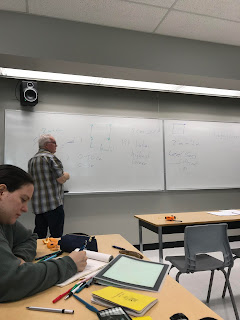After talking about our digital era, we got into a conversation about pseudoarchaeology. Bob explained how many people make a huge profit off of fake archaeology, whether it's through a book, television show or movie. A lot of archaeologists spend time trying to disprove these fake claims and stories, but the public loves to believe in things such as aliens creating the Egyptian pyramids. That also lead us to the topic of ways of knowing. After a student asked a question relating to why people believe in pseudoarchaeology, Bob explained that there are many different frameworks to base opinions off of when studying a subject. Humans can have many explanations for why a flower would grow in a specific place, depending if they base their reasoning off a scientific, religious, indigenous or any other other type of framework. The way you choose to view something all depends on how you grow up, what you study and what you believe.
Before lunch we also talked about the proper method of excavating. Bob spent about an hour detailing everything that we should know about excavating when we get the chance to do so at the McKenzie Creek site. The first thing he talked about was the standard excavation unit we will be using. A 2 meter by 2 meter unit is the Canadian standard, and we will be marking that area with string once it is measured out. Before any digging commences, the coordinates of our unit will be found by linking it with the site datum. A pit datum will also be created in the highest corner of the excavation unit. Attached to the pit datum will be a string that slightly extends the length of the unit so that we can attach a string spirit level to it, and make sure we are digging evenly across the entire unit. Next he explained that he will create arbitrary levels for each unit, and every new level will have its own level bag. Cultural items that are found in the ground that don't meet the criteria of an artifact for this project are put into a level bag, which is labelled with the site name, the coordinates of the unit, the name of the people working in the unit and a summary of what was found in that level. Bob also mentioned that it is very important not to step in anybody else's excavation unit. Only the people who work inside the unit are allowed in it, because you never know if they are in the middle of uncovering an important artifact. The last thing he mentioned that is of high importance is that the edges of a unit must always be straight! It is bad practice to have crooked lines, especially because you could be missing important artifacts, or be veering into another unit.
 |
| Bob talking about excavation units. |
After lunch some people provided updates on their projects, and we made plans about next weeks schedule. We are expecting many guests to visit us in the coming weeks, so a few people also prepared for the groups who will be touring the site. On Monday, most of us will be in the field and some students who haven't gotten the chance yet, will be starting their term projects. See you on Monday!
No comments:
Post a Comment